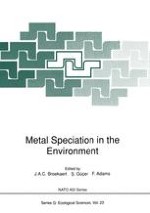1990 | OriginalPaper | Buchkapitel
Biogeochemical Cycling of Atmospheric Selenium
verfasst von : Howard B. Ross
Erschienen in: Metal Speciation in the Environment
Verlag: Springer Berlin Heidelberg
Enthalten in: Professional Book Archive
Aktivieren Sie unsere intelligente Suche, um passende Fachinhalte oder Patente zu finden.
Wählen Sie Textabschnitte aus um mit Künstlicher Intelligenz passenden Patente zu finden. powered by
Markieren Sie Textabschnitte, um KI-gestützt weitere passende Inhalte zu finden. powered by
Selenium was first discovered in 1818 by Jons Jacob Berzelius in deposits from the lead chambers of a sulfuric acid plant at Gripsholm, Sweden. Berzelius realized that the new element was related to tellurium which had been discovered in the late 1700’s. For the first 140 years after its discovery Se was thought to be deleterious to humans and animals. In the 1930’s it was shown that certain plants could accumulate Se to levels which are toxic to livestock. The metabolic disorders “alkali disease” and “blind staggers” were shown to be caused by excess dietary intake of Se. In was only in the late 50’s that Se was shown to be an essential nutrient to animals. The discovery of the “Factor-3 effect” (the anti-oxidant capacity of Se, vitamin D and coenzyme Q) by Schwarz and Foltz (1957) brought about this abrupt change. Further studies then indicated that Se interacted with vitamin D on a variety of deficiency disorders in livestock and poultry. In 1984 it was shown that Se was able to prevent cancer in human (Salonen, 1984).
